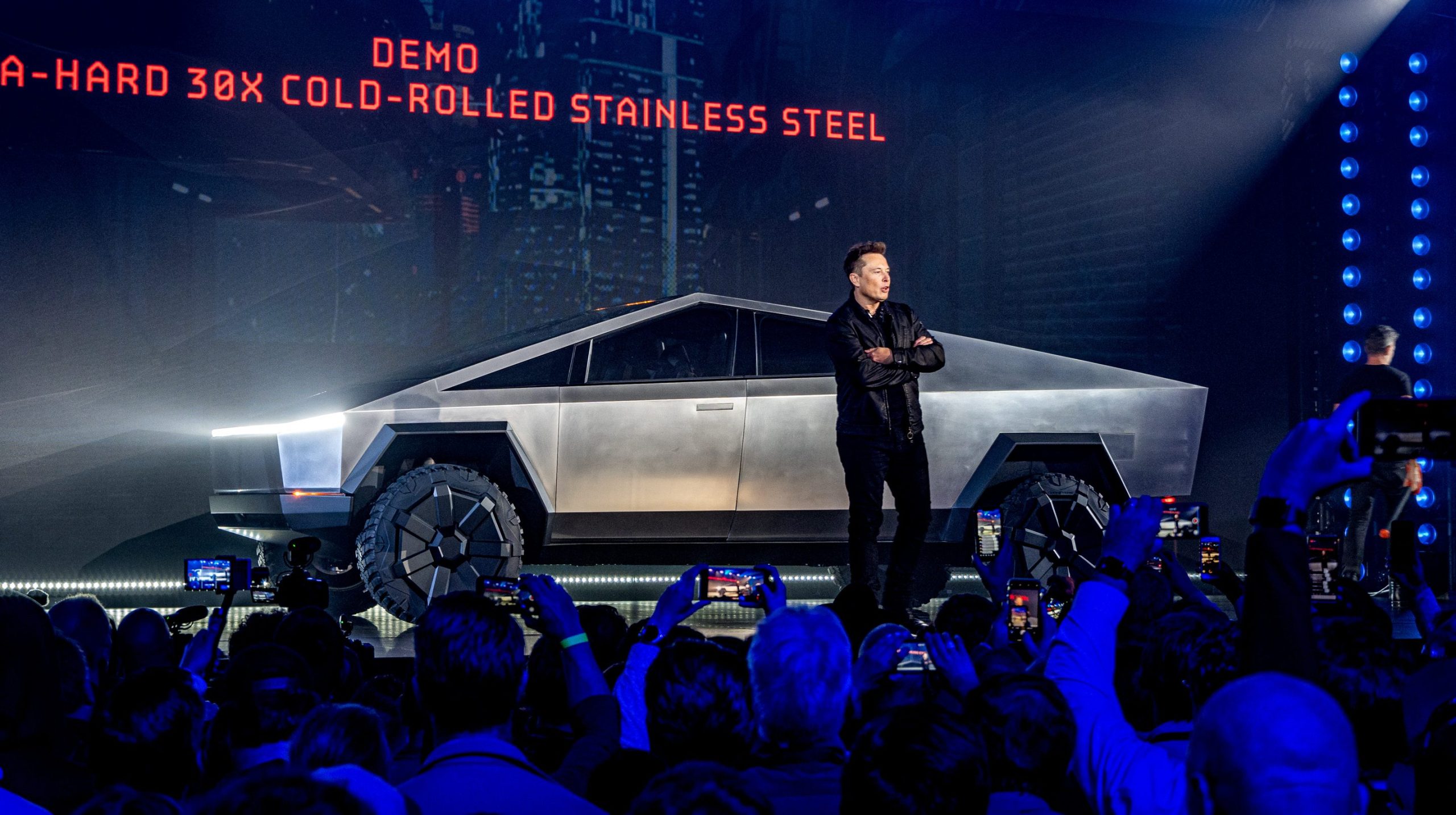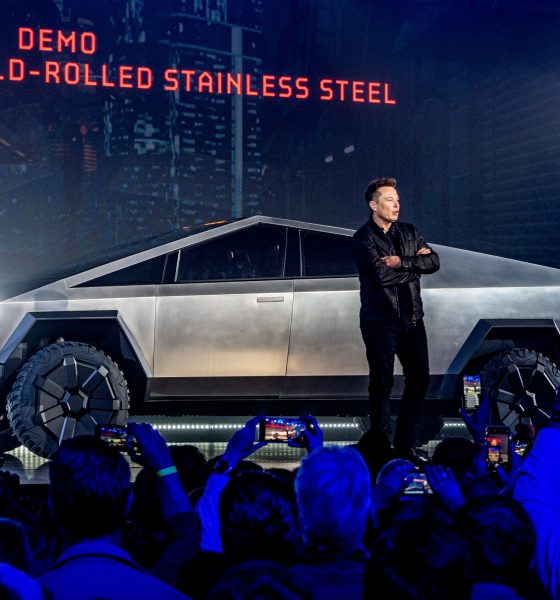

News
Tesla’s Cybertruck delay may have been caused by design finalization
Tesla’s production of the all-electric Cybertruck may have been pushed back due to design finalization by company engineers who have been modifying the vehicle’s dimensions and look.
On Saturday, Tesla’s online configurator for the Cybertruck was officially updated to state that production was starting in 2022. This was a slight change, as previously the configurator, which outlines the variants of each vehicle, when their expected delivery dates are, and pricing, stated that the Tri-Motor variant of the truck would be produced as early as December 2021.
However, this has been pushed back to 2022, as the Model Y is taking priority at Giga Texas, Tesla’s newest facility. Construction is still ongoing, but production nears and could start within the coming weeks, according to some reports. The Cybertruck and Model Y are both slotted to be produced at the plant among other vehicles as well, but it remained unclear what vehicle would take priority. This was until the Q2 2021 Earnings Call where Tesla confirmed the Model Y would be the first vehicle built at the facility, which is located just miles outside of Austin.
Credit: u/X5AT_1/Reddit
It appears that Tesla may have been working on finalizing the design of the Cybertruck, and this instance may have caused the delay. Tesla insider @SawyerMerritt stated earlier today that a company source said Tesla finalized the design of the Cybertruck just recently.
This won’t be much of a surprise but I’ve been told designs were just recently finalized for Cybertruck. Tesla said on the Q2 earnings call that “Cybertruck is at a stage where we finished basic engineering of the architecture; We’re moving into the beta phases later this year.”
— Sawyer Merritt ?? (@SawyerMerritt) August 9, 2021
Teslarati reached out to Merritt for more context, but no more information was able to be shared at the request of the individual who shared it. Merritt said the source was within Tesla.
Earlier this year, Elon Musk stated that Cybertruck engineering was “almost finished” during the Q4 2020 Earnings Call in January. “So we’re no longer iterating at the design center level or design level. We’ve got the designs fixed,” he stated. However, there was some movement on this statement when Musk appeared on the Joe Rogan Experience podcast just a few weeks later.
During the February podcast, Musk stated that the Cybertruck was still going through some minor design modifications related to size. He stated that the Cybertruck unveiled at the Hawthorne Design Studio in November 2019 was “pretty much what it will look like,” but there would be some small differences between that vehicle and the final design. Most of the changes were related to the dimensions of the car. “You know, we adjusted the size a few percent. Like around 3% or smaller. You don’t want it to be a couple of inches too big for the tunnel,” Musk added.
Tesla Cybertruck makes a tight squeeze through Boring Company tunnel
Musk stated during the podcast that the Cybertruck would enter production at Giga Texas late this year and that “if we’re lucky,” some deliveries might be completed by the end of 2021.
Tesla is known to take its time with designing vehicles, making sure the engineering and software of a vehicle are just right. This is most evident with the recent Model S Plaid deliveries, which were slated to begin in February. Tesla didn’t give the Model S Plaid to customers until June 10th, as software and design challenges held up the delivery process. Musk was transparent when announcing the delays, stating that minor tweaks needed to be made for the car to be acceptable.
The Cybertruck is still undergoing many design finalizations, and nothing is set in stone. Recently, Teslarati uncovered the possibility of Tesla installing solar panels on the Cybertruck’s tonneau for increased range. This idea has not been confirmed by Tesla yet, but the patents point toward the potential usage of solar cells to increase traveling distance between charges.
What do you think? Let us know in the comments below, or be sure to email me at joey@teslarati.com or on Twitter @KlenderJoey.

Elon Musk
Starlink passes 9 million active customers just weeks after hitting 8 million
The milestone highlights the accelerating growth of Starlink, which has now been adding over 20,000 new users per day.

SpaceX’s Starlink satellite internet service has continued its rapid global expansion, surpassing 9 million active customers just weeks after crossing the 8 million mark.
The milestone highlights the accelerating growth of Starlink, which has now been adding over 20,000 new users per day.
9 million customers
In a post on X, SpaceX stated that Starlink now serves over 9 million active users across 155 countries, territories, and markets. The company reached 8 million customers in early November, meaning it added roughly 1 million subscribers in under seven weeks, or about 21,275 new users on average per day.
“Starlink is connecting more than 9M active customers with high-speed internet across 155 countries, territories, and many other markets,” Starlink wrote in a post on its official X account. SpaceX President Gwynne Shotwell also celebrated the milestone on X. “A huge thank you to all of our customers and congrats to the Starlink team for such an incredible product,” she wrote.
That growth rate reflects both rising demand for broadband in underserved regions and Starlink’s expanding satellite constellation, which now includes more than 9,000 low-Earth-orbit satellites designed to deliver high-speed, low-latency internet worldwide.
Starlink’s momentum
Starlink’s momentum has been building up. SpaceX reported 4.6 million Starlink customers in December 2024, followed by 7 million by August 2025, and 8 million customers in November. Independent data also suggests Starlink usage is rising sharply, with Cloudflare reporting that global web traffic from Starlink users more than doubled in 2025, as noted in an Insider report.
Starlink’s momentum is increasingly tied to SpaceX’s broader financial outlook. Elon Musk has said the satellite network is “by far” the company’s largest revenue driver, and reports suggest SpaceX may be positioning itself for an initial public offering as soon as next year, with valuations estimated as high as $1.5 trillion. Musk has also suggested in the past that Starlink could have its own IPO in the future.
News
NVIDIA Director of Robotics: Tesla FSD v14 is the first AI to pass the “Physical Turing Test”
After testing FSD v14, Fan stated that his experience with FSD felt magical at first, but it soon started to feel like a routine.

NVIDIA Director of Robotics Jim Fan has praised Tesla’s Full Self-Driving (Supervised) v14 as the first AI to pass what he described as a “Physical Turing Test.”
After testing FSD v14, Fan stated that his experience with FSD felt magical at first, but it soon started to feel like a routine. And just like smartphones today, removing it now would “actively hurt.”
Jim Fan’s hands-on FSD v14 impressions
Fan, a leading researcher in embodied AI who is currently solving Physical AI at NVIDIA and spearheading the company’s Project GR00T initiative, noted that he actually was late to the Tesla game. He was, however, one of the first to try out FSD v14.
“I was very late to own a Tesla but among the earliest to try out FSD v14. It’s perhaps the first time I experience an AI that passes the Physical Turing Test: after a long day at work, you press a button, lay back, and couldn’t tell if a neural net or a human drove you home,” Fan wrote in a post on X.
Fan added: “Despite knowing exactly how robot learning works, I still find it magical watching the steering wheel turn by itself. First it feels surreal, next it becomes routine. Then, like the smartphone, taking it away actively hurts. This is how humanity gets rewired and glued to god-like technologies.”
The Physical Turing Test
The original Turing Test was conceived by Alan Turing in 1950, and it was aimed at determining if a machine could exhibit behavior that is equivalent to or indistinguishable from a human. By focusing on text-based conversations, the original Turing Test set a high bar for natural language processing and machine learning.
This test has been passed by today’s large language models. However, the capability to converse in a humanlike manner is a completely different challenge from performing real-world problem-solving or physical interactions. Thus, Fan introduced the Physical Turing Test, which challenges AI systems to demonstrate intelligence through physical actions.
Based on Fan’s comments, Tesla has demonstrated these intelligent physical actions with FSD v14. Elon Musk agreed with the NVIDIA executive, stating in a post on X that with FSD v14, “you can sense the sentience maturing.” Musk also praised Tesla AI, calling it the best “real-world AI” today.
News
Tesla AI team burns the Christmas midnight oil by releasing FSD v14.2.2.1
The update was released just a day after FSD v14.2.2 started rolling out to customers.

Tesla is burning the midnight oil this Christmas, with the Tesla AI team quietly rolling out Full Self-Driving (Supervised) v14.2.2.1 just a day after FSD v14.2.2 started rolling out to customers.
Tesla owner shares insights on FSD v14.2.2.1
Longtime Tesla owner and FSD tester @BLKMDL3 shared some insights following several drives with FSD v14.2.2.1 in rainy Los Angeles conditions with standing water and faded lane lines. He reported zero steering hesitation or stutter, confident lane changes, and maneuvers executed with precision that evoked the performance of Tesla’s driverless Robotaxis in Austin.
Parking performance impressed, with most spots nailed perfectly, including tight, sharp turns, in single attempts without shaky steering. One minor offset happened only due to another vehicle that was parked over the line, which FSD accommodated by a few extra inches. In rain that typically erases road markings, FSD visualized lanes and turn lines better than humans, positioning itself flawlessly when entering new streets as well.
“Took it up a dark, wet, and twisty canyon road up and down the hill tonight and it went very well as to be expected. Stayed centered in the lane, kept speed well and gives a confidence inspiring steering feel where it handles these curvy roads better than the majority of human drivers,” the Tesla owner wrote in a post on X.
Tesla’s FSD v14.2.2 update
Just a day before FSD v14.2.2.1’s release, Tesla rolled out FSD v14.2.2, which was focused on smoother real-world performance, better obstacle awareness, and precise end-of-trip routing. According to the update’s release notes, FSD v14.2.2 upgrades the vision encoder neural network with higher resolution features, enhancing detection of emergency vehicles, road obstacles, and human gestures.
New Arrival Options also allowed users to select preferred drop-off styles, such as Parking Lot, Street, Driveway, Parking Garage, or Curbside, with the navigation pin automatically adjusting to the ideal spot. Other refinements include pulling over for emergency vehicles, real-time vision-based detours for blocked roads, improved gate and debris handling, and Speed Profiles for customized driving styles.








